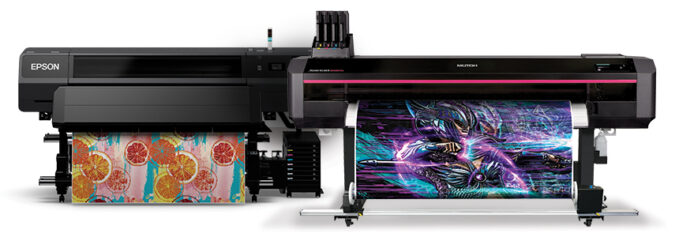
By Cassandra Balentine
In the roll-to-roll (R2R) wide format space, latex/resin- and eco-solvent-based devices are popular options. The technology as well as its potential uses continue to advance. Here, we catch up on the latest and greatest product evolutions in this segment.
Wide format R2R latex/resin and eco-solvent-based devices excel when it comes to banners and other traditional print shop signage, including vehicle wraps, stickers, and heat transfer vinyl apparel, says Michael Litardo, marketing manager, Mutoh America, Inc.
Specific to resin-based printers, David Lopez, product manager, Professional Imaging, Epson America, points out that wallpaper, wall décor, and floor graphics are well suited. “There is a trend using textured materials to create wall graphics and add a new level of interest and tactical feel.”
For those R2R latex/resin or eco-solvent printers with white ink capabilities, clear films, colored media, and multi-layer day/night backlit displays are regularly produced applications, says Buddy Riebel, national director, IP/wide format, and advanced finishing solutions, Ricoh USA, Inc.
The most common size for these devices is 64 inches in width. Tom Wittenberg, large format industry relations and events, NA, HP Inc., cites IDC market research. “We see the largest segment is the 64-inch value space, with about ten percent growth and just under 2,000 units expected for 2024.”
Above, Left to Right: The Epson SureColor R5070 is a 64-inch, R2R resin printer. The Mutoh XpertJet 1641SR Pro is a 64-inch eco-solvent device.
The Investment
The investment for a latex/resin or eco-solvent R2R wide format printer varies based on specifications and user requirements.
Lopez says a common MSRP for an average 64-inch system can range anywhere from $12,000 to $35,000. “The price change is most often attributed to feature set, including speed, color gamut, ink set setup, and software.”
Litardo sees price points generally in the $10,000 to $30,000 price range. “A more expensive machine will have a larger width and typically more printheads for higher output.”
Major Advancements
Among players in the latex/resin and eco-solvent R2R print space, each vendor’s priorities vary in terms of future growth.
For example, Lopez says Epson is focused on advancing sustainability, from daily in-office work to product development and manufacturing, with the goal of reducing its carbon footprint. “This is deeply ingrained in our approach to product design. We are building our systems to last longer, and within that process, focusing on developing compact designs to reduce the physical footprint, require fewer physical materials to manufacture, and need less space during transportation.”
Lopez feels that this methodology is inline with industry trends. “Most of our competitors are also focused on sustainability—everyone is trying to do their part.”
Wittenberg agrees. “HP continues to deliver printers with features like white ink to PSPs that produce a wider range of higher value applications, but also with the most sustainable approach—from eco-friendly cartridges to water-based HP Latex ink to certifications like UL ECOLOGO, UL GREENGUARD Gold, and Energy Star.”
Optimization is another key word. “A lot of the work on our Mutoh printers in the last year has been optimizing new systems that we introduced with the XpertJet series printers. Things like launching the Mutoh AccuFine printheads for up to 40 percent faster print speeds; creating new screening patterns for i-screen to mitigate pass-based banding even further; tuning our automatic adjustment calibrations to be superior to manual technician adjustments; and adding a Nozzle Detection Unit to automatically attempt to recover missing nozzles and conduct remapping as needed,” offers Litardo.
Looking ahead, a big push for Mutoh is speeding up the print-to-lamination waiting period commonly seen with eco-solvent printing. “There are many different components we can look at such as ink chemistry and heater/dryer systems to reduce outgassing time,” adds Litardo. Reducing outgas time is becoming a major trend. This allows print shops to provide a quicker turnaround on vehicle graphics and other laminated signage.
Features that expand color gamut are in demand. The most recent advancement to Ricoh’s second generation latex product is the addition of orange and green to further expand the color gamut, says Riebel.
In addition to orange and green, white ink is another popular option. “More users are starting to use white ink for high-value applications. Because HP Latex offers an on demand white solution that eliminates time and waste we are seeing a stronger demand for white ink capabilities,” shares Wittenberg.
Replacement Considerations
One aspect concerning the health of wide format industry segments is the replacement rate. This is either due to demand for a new technology or replacing a unit as it meets the end of its lifecycle.
Litardo quips that “print shops use equipment until the wheels fall off, and then some,” when it comes to replacing equipment.
Lopez doesn’t expect to see its resin units retired anytime soon, especially with printhead advancements and different ink sets available in this market. “I do see manufacturers upgrading these products. Customers are always looking for faster hardware with higher quality.”
R2R Check In
Latex/resin and eco-solvent R2R printers are popular for a range of applications associated with the modern wide format print shop, from signs and banners to vehicle wraps and backlit signage.
We continue the R2R discussion in the next issue with a look at UV solutions.
Dec2023, Digital Output


